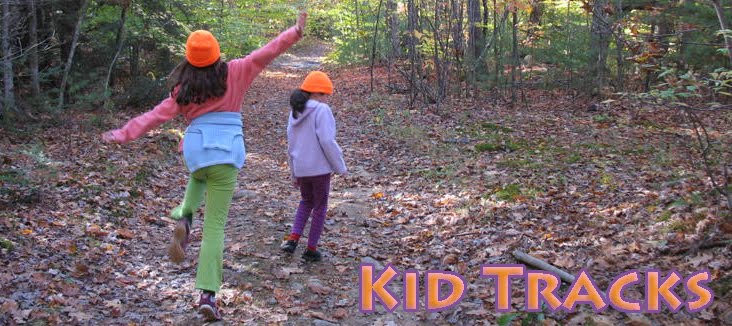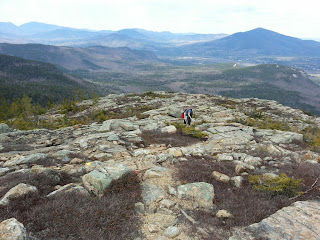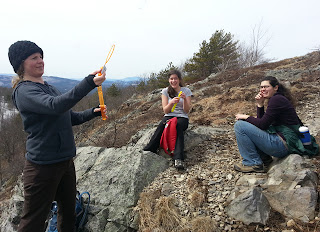For instance, we got off to a slow start due to me not having time to food shop so I had to pick up sandwiches for our mountain top lunch. I lamented the late start but c'est la vie with my schedule lately.
Then a woman at the trailhead locked her car keys in her car and asked us to borrow a phone to call for a rescue. This prompted Shannon and my 15-year-old to discuss yoga moves – and then try them – while we waited for the woman to make her call(s).
You can see the woman making her call behind Shannon.
We have hiked to Diana's Baths many times and it is still a treat to see the waterfalls in the spring. But truth be told, you have to see – and hear – the falls to really appreciate the splendor.
Roundtrip to Diana's Baths is about a mile on fairly level terrain. It's a nice (young) family-friendly hike.
Despite many visits, this was the first time we'd planned to follow the Red Ridge Trail that snakes up the river to the Moat Mountain loop. I had read in the AMC White Mountain Guide that there would likely be at least one or two tough river crossings that might not be passable in the spring.
It turned out they were not as scary as anticipated but they still required some problem-solving skills and a bit more effort than usual.
The first was the typical walk across on logs. The logs didn't feel all that steady to the adults of the group so Shannon decided to head down the river to a large log she had to straddle and shimmy across. I didn't think the straddle thing looked all that fun so I found another way to cross. We each had our own style and we had a good laugh about it.
Then there was the next big crossing that did not offer stepping stones or logs. After walking up and down the river bank in each direction we determined the only way to get across was to walk through the water. There were no stepping stones above the water and it was only knee-deep. So we pulled off our socks and boots to walk across barefoot. The water was so incredibly cold that my 15-year-old said her feet felt like they were burning from the cold. Not so comfortable but it was a narrow crossing and we all did it without incident.
It's quite challenging to photograph "cold" but trust me, these red feet were dang cold after our river walk-across.
On the return trip across the bare footed crossing, my 15-year-old wore her wool socks to protect her feet from the cold water. It was a good thing I had an extra pair of socks for her to wear on the hike back to the car. I've learned extra socks are a must on mountain trail hiking.
Then there was the third crossing, which was the fastest moving water we encountered. There were stepping stones to jump but it required a not very direct route across with lots of jumping and a good balancing act for each of us.
Other than the river crossings (which really do require some agility so be ready for that if you visit this trail at this time of year), it was a fairly easy hike for the first couple of miles until the terrain started upward. Then the climb was all business and required serious stamina.
If you were out on the trail the day we were, you likely could have heard our exclamations that every time we hit a rock plateau, we saw another one before us.
You can see the top of this pile and it really does look like the summit. But no, once reached the view would be another just like it.
After four plateaus I decided I was taking a break. Shannon and my 15-year-old climbed one more plateau and I believe they could be heard for miles with their "ugh! There's another one!" exclamations.
I was happy I took a snack break while they made that last discovery.
Despite the fact that we did not make it to the summit of the "unnamed peak" on the Red Ridge Trail portion of the Moat Mountain loop (had we continued after the unnamed peak we would have gone done a steep decline for a bit before climbing up to the summit of Moat Mountain), we felt accomplished. We covered approximately 9 miles total roundtrip and climbed about 1,900 feet. These were the highest numbers of our season so far (we are hoping to tackle Mt. Washington this year so we need to pay attention to our numbers to ensure we can really do that climb).
More important than those numbers however, was the fact that we had some good belly laughs and a memorable hike despite the fact we didn't summit any mountains.
But the consolation was that the view at the elevation we did climb really was awesome.
Here's a peak at our interactive map of the trip. The mileage is off (thanks to a wiggy android GPS app) but the terrain and photo placement is accurate.
Red Ridge Trail on Moat Mountain
My Kid Tracks column runs in print the second Sunday of every month in the Outdoors section of the Telegram.



























